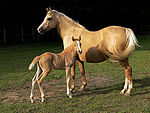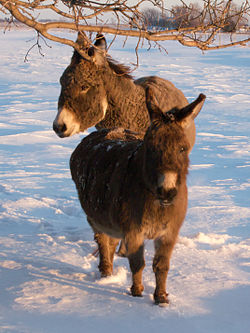- North American donkey
-
North American donkeys constitute approximately 0.1% of the worldwide donkey population.[1] Donkeys were brought to the New World by the Conquistadores in the 15th century,[2] and spread northward.[3] There are no North American donkey breeds as such.[4] Instead, donkeys in Canada and the USA are classified according to their size: Miniature donkeys are 36 inches (91 centimetres) or less at the withers, Small Standard donkeys stand 36.01 to 48 inches (91 to 122 cm), Large Standard donkeys stand from over 48 to 54 inches (122 to 137 cm) for jennets, and over 48 to 56 inches (122 to 142 cm) for jacks and geldings, while Mammoth Jack jennets are over 54 inches (137 cm), and Mammoth jacks and geldings over 56 inches (142 cm).[3][5][6]
Contents
Early history
The first asses came to the Americas on ships of the Second Voyage of Christopher Columbus, and were landed at Hispaniola in 1495.[2] In the early days of the Conquest, jack-asses were highly valued as sires for mules,[7] which were esteemed as riding-animals by the Spanish, and reserved for the nobility.[8] Mules were bred for expeditions to mainland America, with males preferred for pack animals and the females for riding. The first shipment of mules, including three jacks and twelve jennets, arrived in Mexico from Cuba ten years after the conquest of the Aztecs in 1521. Mules were used in silver mines, and each Spanish outpost in the empire bred its own mules from its own jack. Donkeys arrived in large numbers in the western United States during the nineteenth century gold rushes, as pack animals and for use in mines and ore-grinding mills. The major use of donkeys came to an end with the end of the mining boom and the introduction of railroads in the West. With little value, many animals were turned loose to become the populations of free-roaming burros that inhabit the West today.[9]
Miniature donkey
In the 20th century, donkeys came to be more frequently kept as pets in the United States and in other wealthy nations. In 1929 Robert Green imported seven donkeys of the small indigenous Sardinian breed to the United States. The first foal was born in the same year. Although never considered miniature in their country of origin, these animals were soon known as Miniature or Miniature Mediterranean donkeys. Green was a lifelong advocate, and said of them, "Miniature donkeys possess the affectionate nature of a Newfoundland, the resignation of a cow, the durability of a mule, the courage of a tiger, and an intellectual capability only slightly inferior to man's." By 1935 there were 52 of them, and some were sold. Further Sardinian donkeys were imported, as well as similar but quite distinct Sicilian animals. A breed registry was opened in 1958 by Bea Langfeld, who was the first professional breeder of miniature donkeys in the USA; it was turned over to the American Donkey and Mule Society in 1987.[10]
Standard donkey
Mammoth Jack
The Mammoth Jack, also called Mammoth Jackstock, American Mammoth Donkey, or American Mammoth Jack, is the largest North American donkey. It descended from several large European donkeys imported to the United States from about the time of George Washington. Breeds that may have influenced the Mammoth Jack include the Maltese donkey, the Baudet de Poitou, the Andalusian donkey, the Majorcan donkey and the Catalonian donkey.[11]
Spotted Ass
A spotted ass is any kind of donkey, mule or hinny that has a spotted coat. To be registered with the American Council of Spotted Asses[12], the animal must have at least two spots behind the throatlatch and above the legs. The throatlatch (called throatlash in Great Britain) is the minimum-circumfrence part of the neck, just behind the bend of the jaw. Eligible animals include donkeys, mules (offspring of a jack [male donkey] and a mare [female horse]), and hinnys (offspring of a stallion [male horse] and a jenny or jennet [female donkey]).
Breed associations
- The American Council of Spotted Asses
- The American Donkey and Mule Society
- American Mammoth Jackstock Registry
- Canadian Donkey & Mule Association
See also
- American Mammoth Jackstock on French Wikipedia
- List of donkey breeds
References
- ^ Waltraud Kugler, Hans-Peter Grunenfelder, Elli Broxham (2008). Donkey Breeds in Europe: Inventory, Description, Need for Action, Conservation; Report 2007/2008. St. Gallen, Switzerland: Monitoring Institute for Rare Breeds and Seeds in Europe. http://www.save-foundation.net/pdf/donkey.pdf.
- ^ a b Roots, Clive (2007). Domestication. Westport: Greenwood Press. p. 179. ISBN 9780313339875. http://books.google.com/books?id=WGDYHvOHwmwC.
- ^ a b "The Donkey". Government of Alberta: Agriculture and Rural Development. 1990. http://www1.agric.gov.ab.ca/$department/deptdocs.nsf/all/agdex598. Retrieved August 2011.
- ^ Dent, Anthony (1972). Donkey: The Story of the Ass from East to West. London: Harrap. ISBN 9780245599323. "There is no breed of ass that can be regarded as a specific and original American development", cited by "The Donkey". Government of Alberta: Agriculture and Rural Development. 1990. http://www1.agric.gov.ab.ca/$department/deptdocs.nsf/all/agdex598. Retrieved August 2011.
- ^ "All About DONKEYS!". The American Donkey and Mule Society. http://www.lovelongears.com/about_donkeys2.html. Retrieved August 2011.
- ^ "About donkeys". Canadian Donkey and Mule Association. http://web.me.com/goatkeeper1/cdma2/Donkeys.html. Retrieved August 2011.
- ^ Salmon, Thomas ([1744]-46). Modern history: or, the present state of all nations. Describing their respective situations, persons, habits, and buildings; manners, laws and customs, religion, and policy; Arts and Sciences, Trades, Manufactures and Husbandry; plants, animals, and minerals. By Mr Salmon. Illustrated with cuts and maps, accurately drawn according to the Geographical Part of this Work, by Herman Moll. The third edition. With considerable additions and improvements, interspersed in the body of the work: Also the History and Revolutions of each Country, brought down to the present Time. Volume 3 (3rd ed.). London: printed for T. Longman, in Pater-Noster-Row. T. Osborne, in Grays-Inn. J. Shuckburgh, in Fleet-Street. C. Hitch, in Pater-Noster-Row. S. Austen, in Newgate-Street. And J. Rivington, in St Paul’s Church-Yard, MDCCXLIV.. p. 284.
- ^ Kilgore, Anthony (1858). "An Essay on the Ass and Mule". Working Farmer IX: 284. http://books.google.com/books?id=peNFAAAAYAAJ. Retrieved August 2011.
- ^ Olsen, Sandra L., (ed.) (1996). Horses Through Time. Boulder, Colorado: Roberts Rinehart Publishers for Carnegie Museum of Natural History. ISBN 9781570980602., cited at "Donkey". The International Museum of the Horse. Kentucky Hose Park, Lexington, KY. http://imh.org/horse-breeds-of-the-world/donkey/. Retrieved August 2011.
- ^ "The History of The Miniature Mediterranean Donkey". The Donkey & Mule Society of New Zealand. http://www.donkey-mule.org.nz/Register/Medd_Form/Mini_history.pdf. Retrieved August 2011.
- ^ Jones, Diane. "The Mammoth Jack". Windt im Wald Farm. http://www.wiwfarm.com/Mammoth.html. Retrieved August 2011.
- ^ "American Council of Spotted Asses New Home Page". http://www.spottedass.com/ACOSA_2/faq.aspx.
Equine Equine science and
management
Equestrianism
and sportGlossary of equestrian terms · List of Equestrian Sports · Horse tack · Bit · Bridle · Saddle · Harness · English riding · Western riding · Driving · Horse training · Horse racing · Equestrian at the Summer Olympics (medalists, venues) · Horse show · EquitationEvolution and history Domestication · In warfare · In the Middle Ages · Horses in East Asian warfare · History of the horse in South Asia · Horses in the Napoleonic Wars · Horses in World War I · Horses in World War II · History of the horse in BritainHorse breeds, types
and other EquidaeList of horse breeds · Wild horse · Feral horse · Stock horse · Gaited horse · Draft horse · Warmblood · Sport horse · List of horse breeds in DAD-ISOther EquusHybridsCategories:- Donkeys
- Feral animals
- Domesticated animals
Wikimedia Foundation. 2010.

